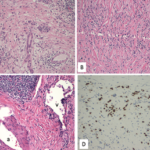The third step is the application of eight, weighted, inclusion criteria domains that address clinical findings, serologic results, radiologic assessments and pathology interpretations. As noted above, a sum of at least 20 points from these inclusion criteria yielded very high specificity and moderately high sensitivity.
Using the Criteria
Importantly, rheumatologists should understand that a patient does not have to have an elevated IgG4 serum concentration to be classified as having IgG4-RD, Dr. Stone explains. Serum IgG4 levels are normal in a substantial percentage of patients with clinicopathologic diagnoses of IgG4-RD. Elevated IgG4 gives four points toward classification but must occur in combination with other features to reach the threshold. More important are radiologic findings consistent with IgG4-RD, such as a sausage-shaped pancreas and periaoritis affecting the infrarenal aorta.
The criteria were designed to imitate the path clinicians will take toward diagnosis, Dr. Stone explains. As such, they do not require a biopsy for classification of IgG4-RD. Most of the patients assessed in the study did have biopsies, but biopsy data were primarily used for exclusion. However, a closer examination of the false-negative cases in the validation cohorts revealed the majority of these patients fell short of the 20-point cutoff because they were less likely to have had biopsies compared with true-positive cases.
As research in IgG4-RD advances, rheumatologists will likely lead most of the clinical trials investigating targeted treatments for IgG4-RD that can spare patients from the toxicities of conventional treatments. The new classification criteria will allow rheumatologists to accurately identify patients for inclusion in clinical, epidemiological and basic investigations and are already being used as entry criteria for clinical trials.
Lara C. Pullen, PhD, is a medical writer based in the Chicago area.


